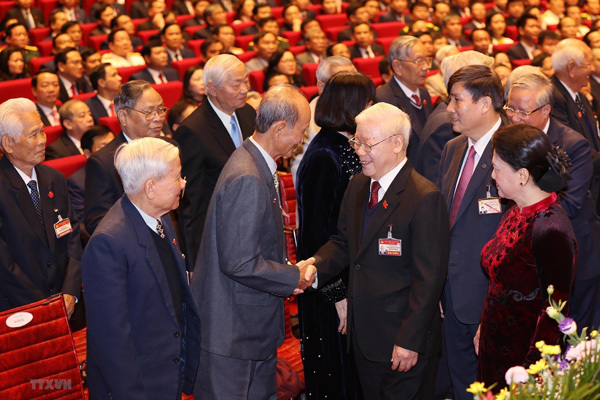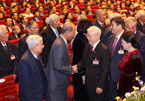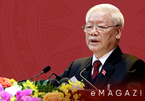At the opening ceremony of the 13th Party Congress, Mr. Trong presented the report of 12th Party Central Committee on documents submitted to the 13th Party Congress, which emphasized the goals: improving leadership, ruling capacity and fighting strength of the Party; building a clean, strong, Party and political system; strengthening people's trust in the Party, State, and socialist regime; arousing aspirations for developing a prosperous and happy country, promoting the will and strength of great national solidarity combined with the power of the times; promoting comprehensively and synchronously the cause of innovation, industrialization and modernization; building and firmly defending the Fatherland, maintaining a peaceful and stable environment; and striving for the goal of turning Vietnam into a socialist-oriented developed country by mid-21st century.
The specific objectives in the coming decades are: By 2025, Vietnam will be a developing country with modern industry, surpassing the low middle-income status. By 2030, Vietnam will be a developing country with modern industry and high average income. By 2045, it will become a developed country with high income.
VietNamNet would like to introduce articles on this topic with the desire to contribute a voice for Vietnam to achieve these goals.
 |
|
General Secretary and State President Nguyen Phu Trong affirmed that in all the work of the Party and State, it is necessary to always thoroughly grasp the viewpoint "people are the roots". Photo: Pham Hai
|
Among these issues, there is a core point "Taking people as the roots". General Secretary and State President Nguyen Phu Trong affirmed that in all the work of the Party and State, it is necessary to always thoroughly grasp the viewpoint "people are the roots"; truly believe, respect and promote the people's mastery, persevere in implementing the motto "people know, people discuss, people do, people check, people supervise, people benefit".
He said: “The people are the center, the subject of the cause of renovation, construction and defense of the country, all policies must really come from life, aspirations, rights and legitimate interests of the people, taking the happiness and well-being of the people as the target to strive. To tighten the close relationship between the Party and the people, rely on the people to build the Party, and consolidate and strengthen the people's trust in the Party, the State and the socialist regime”.
There is no need to repeat lessons in distant history, but only see recent proof, when the country took "the people as the roots" and "promoted the people's mastery", then the country prospered, made many breakthrough achievements, and mobilized material and spiritual resources of the people for national development.
Great development potential
After the Doi Moi (reform) policy was launched at the 6th Party Congress in 1986, the single-component economy was transformed into a multi-component one which essentially untied the people so that the people could contribute to national construction. The economy became as fresh, vibrant, prosperous and diverse as it is today.
A series of very high development goals that require persistent aspirations have been set at this Congress: By 2025, Vietnam will be a developing country with modern industry, surpassing low middle-income status. By 2030, Vietnam will be a developing country with modern industry and high average income. By 2045, it will become a developed country with high income.
A country with a population of 100 million people with a quarter under the age of 35 and a favorable geostrategic position like Vietnam, has enormous development potential. Setting development goals with these specific milestones is very relevant.
It takes a lot of simultaneous and persistent factors and solutions to fulfill that aspiration, but the most important factor must be the Vietnamese people. Vietnam must take the "people as the roots" to continue promoting human capacity and material resources of the people for national development, for rapid and sustainable economic growth.
Lessons from Korea's achievements
Looking back at the previous periods, economic growth was not fast enough to narrow the development gap, to catch up with and achieve the set goals. The growth rate tended to decrease, from an average of 7.34% per year in the 1991-2000 period to 6.82% per year in the 2001-2010 period, and about 5.9% in the 2011-2020 period.
If compared with the set target of 7%-8% per year on average of the Socio-Economic Development Strategy for the period 2011-2020, the current average growth rate is relatively low - lower than that of other countries during the first period of industrialization.
Since 1990, Vietnam had only five years reaching an average growth rate of 8.21% per year (the 1991-1995 period).
In 30 years (1960 - 1990), South Korea’s average GDP growth rate was 9.58% per year, including 14 years with over 10%; the highest rate was 14.8% (1973). In the period 1977 – 2007, China’s average growth rate was 10.02% per year, with the highest rate (1984) of 15.14% and 15 years with growth rate of over 10%.
According to the World Bank (WB), Vietnam needs to maintain a growth rate of 7% in the next two decades to reach the high income threshold by 2045. The potential growth rate has slowed to around 6.5% in the past decade.
Moreover, in the coming time, forecasts on Vietnam’s growth show that without reform, Vietnam's growth potential will continue to decline. As workforce growth slows down, the potential growth rate is estimated to reduce to 6.3% over the next decade and then gradually decrease to 5.5% over the period 2041-2045.
The Central Institute for Economic Management cited the World Bank in a recent report that Korea, after achieving Vietnam’s current level of per capita income in 1972, doubled its per capita income after only 10 years and multiplied it by 5 times after 20 years.
Such rapid achievement is the result of a combination of increased investment in physical and human resources and, above all, improved efficiency, as reflected in the increasing contribution of productivity (measured in total factor productivity - TFP) to GDP, from 16% in the 1970s to 43% in the 1980s and 56% in the 2000s.
Therefore, it can be argued that Korea succeeded in transitioning from a middle-income to high-income economy by more effectively managing existing resources rather than just accumulating more resources.
Making clearer market factors
In the draft political and economic documents of the 13th Party Congress, there are a number of developmental views similar to that argument, especially the economic model - "modern market economy, international integration, operate fully and synchronously in line with the laws of the market economy…”.
The draft political report requires continuing to improve the institution, fully and comprehensively develop market factors and types of markets. Develop a market for factors of production (goods, services; finance, money; science, technology; land; labor) so that the market plays a decisive role in mobilizing, distributing, and using use of resources.
Thus, in the next decade, market factors and types of markets will continue to be clarified and improved so that resources will be allocated and used more effectively.
Instead of the ask-give mechanism in resource allocation, the market will promote a fair, transparent role in resource allocation, so that people and businesses that are the most deserving know how to use them most effectively will have access to resources.
To better implement the mechanism of resource allocation according to the market, the State will not lose money or people, but people and businesses have more resources for development. A more prosperous and developed country can ensure that "no one will be left behind".
Tu Giang

The Party General Secretary with wit, simple lifestyle
The top leader of the Party and State of Vietnam is indeed an outstanding politician in terms of qualifications, solid political courage, and high prestige, who has a very simple lifestyle.

Party Secretary General, State President Nguyen Phu Trong and determination to clean and purify the apparatus
The disciplining of a series of high-ranking officials, including incumbent and retired ones, shows that the fight against corruption and wrongdoings in the last five years has been accelerated